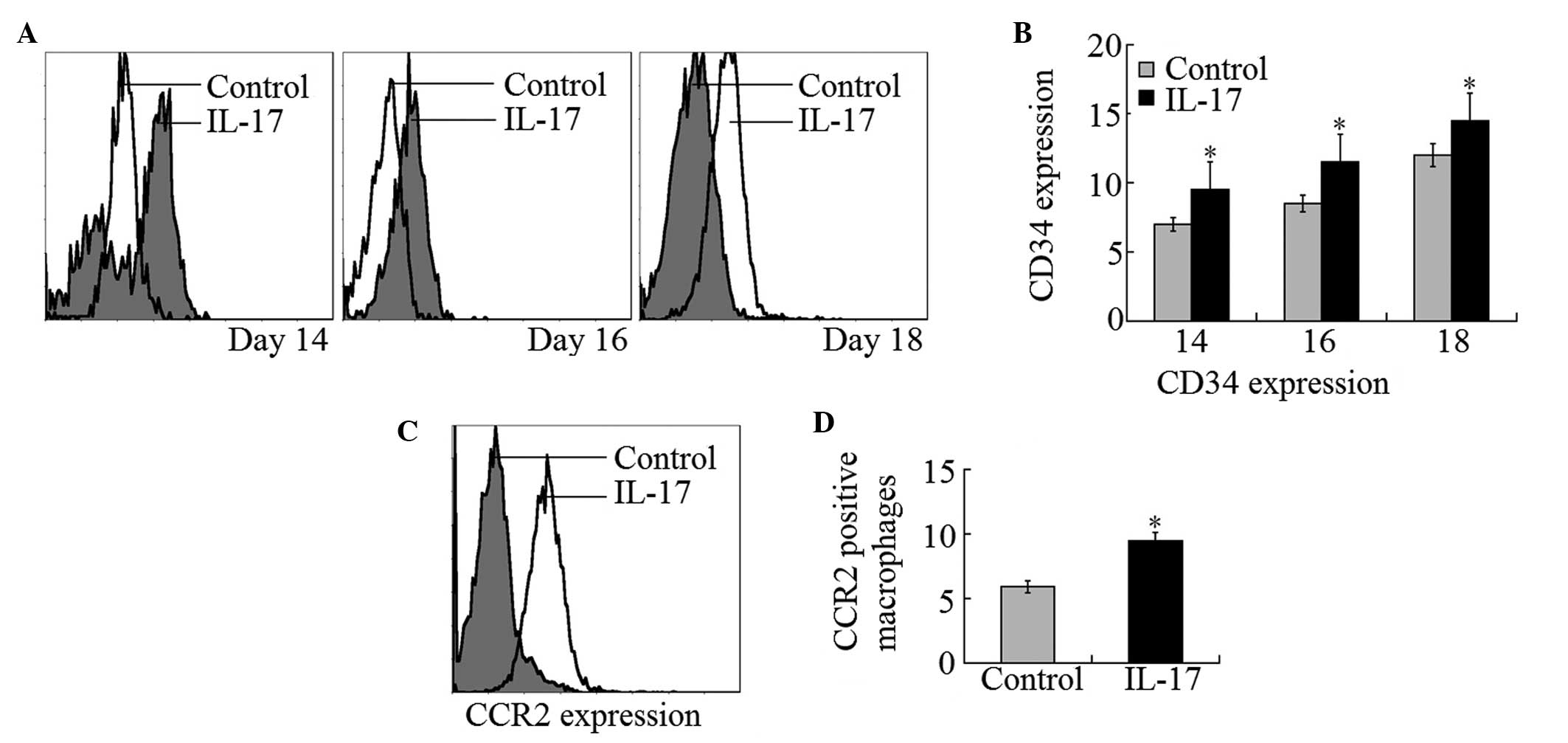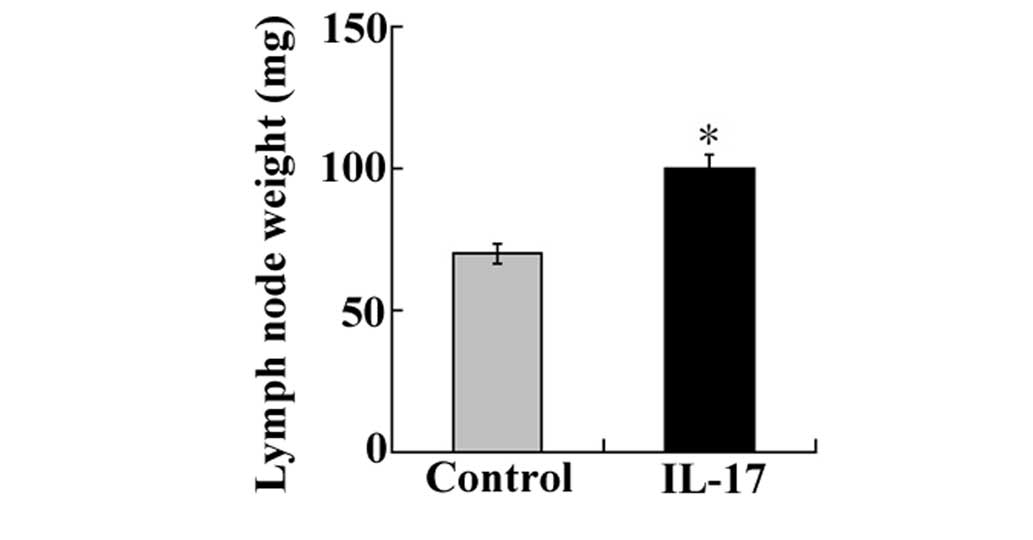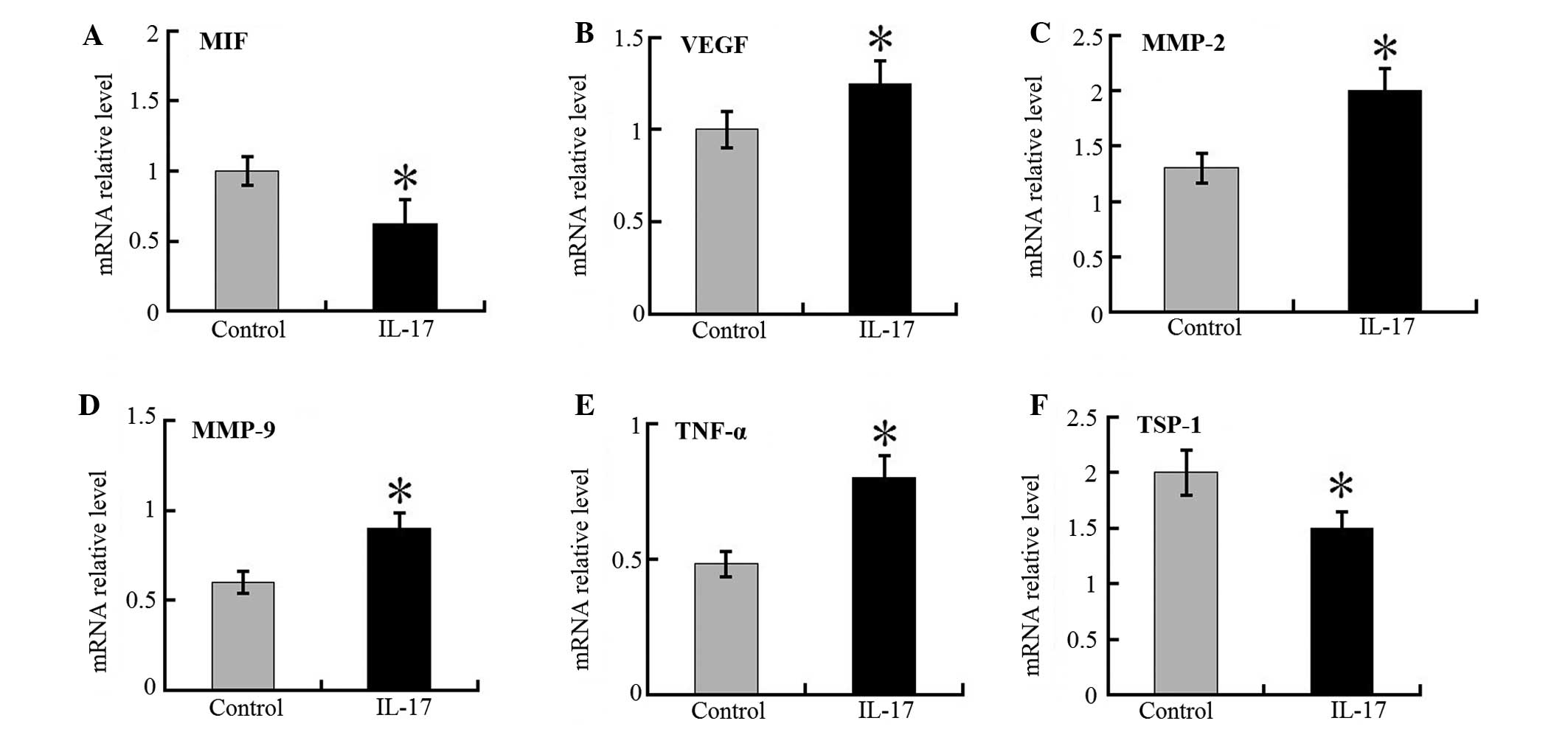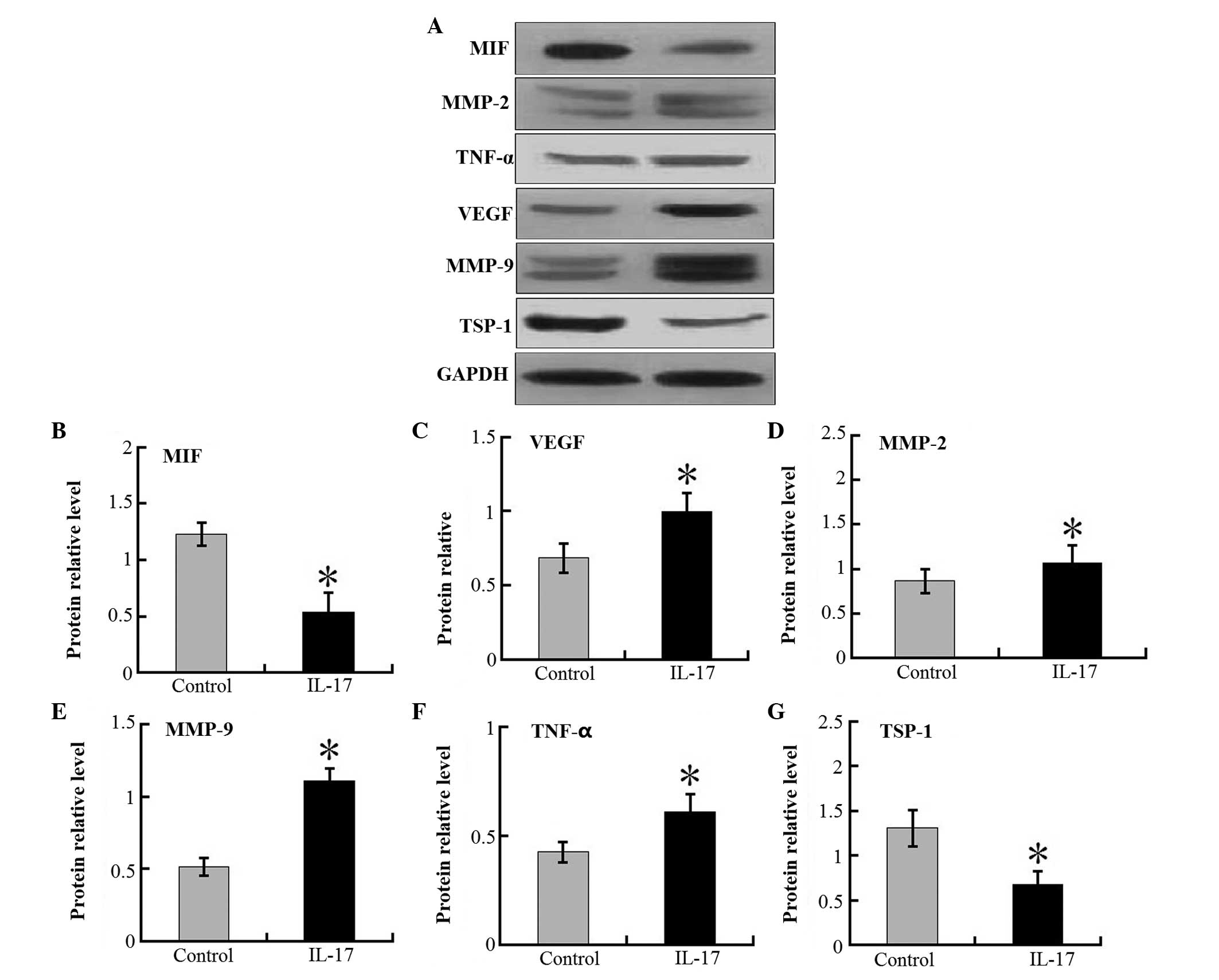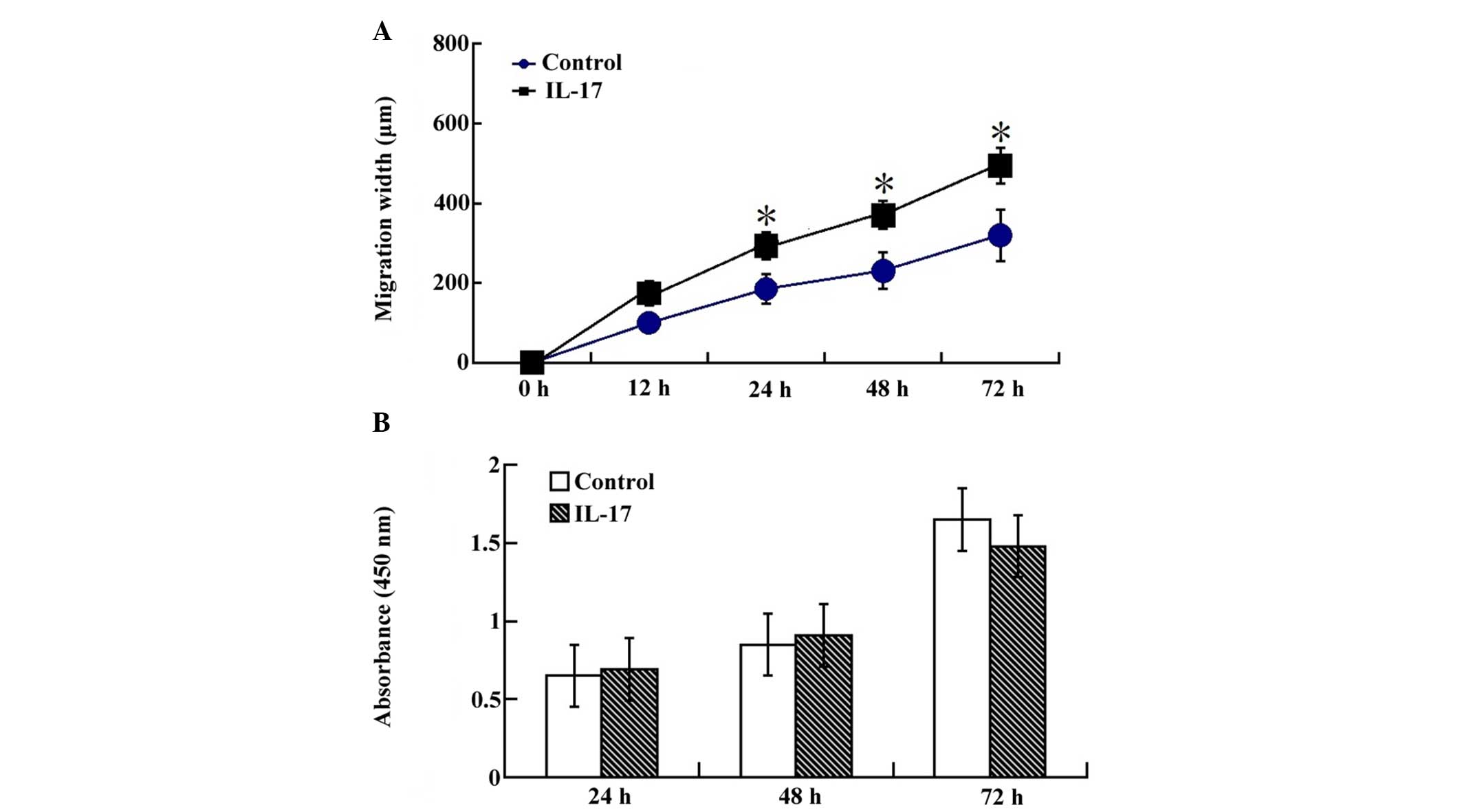Interleukin-17 potently increases non-small cell lung cancer growth
- Authors:
- Published online on: December 18, 2015 https://doi.org/10.3892/mmr.2015.4694
- Pages: 1673-1680
Abstract
Introduction
Non-small-cell lung cancer (NSCLC) is one of the most common types of malignancy worldwide (1). With >1,000,000 novel cases per year, lung cancer represents the most frequent lethal neoplasm in males, while its incidence increases progressively in females (2). Despite considerable efforts, only 5–10% of patients survive 5 years after diagnosis and the majority of these long-term survivors undergo surgery (3). Therefore, tumor angiogenesis and tumor metastasis to multiple organs is a critical problem for patients with lung cancer. The prevention and treatment of tumor angiogenesis and tumor metastasis is clinically important (4).
Interleukin (IL)-17 is produced predominantly by activated CD4 T cells (5). It has pleiotropic biological activities including induction of IL-6, CXCL8/IL-8 and vascular endothelial growth factor-A (VEGF-A) (5–14). IL-17R is a type 1 transmembrane protein with an extraordinarily long intracellular domain (5,15). Although the expression of IL-17 mRNA is restricted to activated T cells, the expression of IL-17R mRNA has been detected in nearly all cells and tissues (5,15). In its role as a proinflammatory cytokine, IL-17 levels have been found to significantly increase in rheumatoid arthritis synovium and in other chronic inflammatory diseases, including multiple sclerosis and psoriasis (16–20). IL-17 has also been implicated in certain tumors, affecting tumorigenesis, proliferation, angiogenesis and metastasis. This allows the tumor to adapt and to confer immune and chemotherapy resistance (21). Accumulating evidence has shown that IL-17-positive cells are frequently present in multiple inflammation-associated cancers and that IL-17 promotes angiogenesis in tumor models (22). Expression of IL-17 is correlated with the number of blood vessels in human ovarian cancer (23), hepatocellular carcinoma (24) and NSCLC (25), and with poor survival in hepatocellular carcinoma (24).
Although IL-17 is central in endothelial proliferation and tumor growth in several types of cancer (23), its possible effects on lung cancer and the precise mechanism underlying its biologic function remain unclear (24,25). To further address the roles of IL-17 in lung cancer, Lewis lung carcinoma (LLC) cells were transplanted into C57BL/6 mice to examine the roles of IL-17 in the processes of tumorigenesis and metastasis in vivo. Tumor size, lymph node weight and angiogenic factors, which were expressed in tumor mass, as indicated at the time point following implantation were detected and compared. The present study provided definitive evidence of a critical role of IL-17 in LLC cell-implanted tumor growth and metastasis.
Materials and methods
Reagents and antibodies
Mouse recombinant protein IL-17 was purchased from Biochem Technologies (Shanghai, China). Rat anti-mouse CD34 monoclonal antibody (mAb) (MEC 14.7, cat no. NB600-1071), phycoerythrin (PE)-conjugated rat anti-mouse F4/80 mAb (cat no. NBP2-22134), rat anti-mouse vascular endothelial growth factor (VEGF) mAb (RM0009-2G02, cat no. NB110-61025), rabbit anti-mouse matrix metalloproteinase (MMP)2 mAb (cat no. NB200-193), rabbit anti-mouse MMP9 mAb (cat no. NBP1-39597), rabbit anti-mouse tumor necrosis factor (TNF)-α mAb (cat no. NB100-57620) and mouse anti-mouse glyceraldehyde 3-phosphate dehydrogenase (GAPDH) mAb (cat no. NB300-328H) were purchased from Novus Biologicals (Littleton, CO, USA). Allophycocyanin-conjugated rat anti-mouse CCR2 mAb (cat no. LS-C127284-100) was purchased from LifeSpan BioSciences (Seattle, WA, USA). Rat anti-mouse migration inhibitory factor (MIF) mAb (cat no. MAB1978) was purchased from R&D Systems (Minneapolis, MI, USA). Rabbit anti-mouse thrombospondin (TSP)-1 mAb (cat no. orb7127) was purchased from Biorbyt (San Francisco, CA, USA).
Cell line and mice
LLC cells, a murine non-small cell lung carcinoma cell line, were purchased from Shanghai Biotechnology Corporation (Shanghai, China). Cells were maintained in Dulbecco's modified Eagle's medium (Sigma-Aldrich, St. Louis, MO, USA) supplemented with 10% fetal calf serum (Thermo Fisher Scientific, Waltham, MA, USA). C57BL/6 mice (n=192) weighing 20–25 g were supplied by the Immunology Laboratory of Nanjing Medical University (Nanjing, China) and were kept in our animal facility under specific pathogen-free conditions. All animal experiments were approved by the Guideline for the Care and Use of Laboratory Animals on the Chinese Medical Academy and the Nanjing Medical University Care Committee. Animals were kept in groups of 5 and fed regular lab chow and water ad libitum. A 12-h light/dark cycle was maintained.
Cell culture and tumor implantation model
LLC cells were grown in RPMI-1640 (Thermo Fisher Scientific) culture medium containing 10% fetal bovine serum, 2 mM L-glutamine, 2 mM sodium pyrovate, 20 mM HEPES, 1% non-essential amino acid, 100 µg/ml streptomycin and 100 U/ml penicillin. Cells were maintained at 37°C with 5% CO2. Cells were progressively passed to larger plates and allowed to reach ~90% confluence. Cells were harvested by trypsinization, washed with HBSS buffer (Life Technologies, Grand Island, NY, USA) three times and resuspended at 1.0×107 cells per ml in serum-free HBSS buffer. LLC cells (1×106) in 100 µl HBSS buffer were injected subcutaneously into 8-week-old male C57BL/6 mice (n=144). Tumor growth was assessed on day 6, 8, 10, 14, 16 and 18 after LLC cell injection by the measurement of two bisecting diameters in each tumor using calipers. The size of the tumor was determined by direct measurement of the tumor dimensions. The volume was calculated according to the equation: V=(L×W2) × 0.5, where V=volume, L=length and W=width (22). On day 14 after tumor implantation, the mice were anaesthetized using 1.2%, 0.2 ml/10 mg 2-Tribro moethanol (Sigma-Aldrich) and sacrificed by dislocation of the cervical spine, and the tumor tissues were dissected and weighed.
Macroscopic assessments of cervical lymph node metastasis
The mice were sacrificed on day 21 after the implantation of LLC cells, and cervical tissues surrounding tumor masses were excised en bloc. The nearby cervical lymph nodes were removed and their weights were measured immediately.
Flow cytometric analysis of CD34-, CCR2- and F4/80-positive cells
Tumor tissues dissected from C57BL/6 mice (n=48) were minced with scissors, and were homogenized in RPMI-1640 medium. Cell suspensions were then passed over a nylon filter with a 100-µm pore size. The resultant cells were further stained with rat anti-mouse CD34 mAb followed by staining with PE-conjugated swine anti-rat IgG mAb. In an assay to detect CCR2+/F4/80+ cells, cells were stained with PE-conjugated rat anti-mouse F4/80 mAb and allophycocyanin-conjugated rat anti-mouse CCR2 mAb. Fluorescence intensities were determined using a FACS Calibur flow cytometer (Becton-Dickinson, Franklin Lakes, NJ, USA), together with samples stained with non-immunized swine IgG (cat. no. DAGIC1433; Creative Diagnostics, Shirley, NY, USA) or rat IgG (cat. no. DAGIC1336; Creative Diagnostics) as an isotype control.
Reverse transcription-quantitative polymerase chain reaction (RT-qPCR)
Total RNAs were extracted from LLC cells from mice (n=48) with the use of the RNeasy Mini kit (Qiagen, Tokyo, Japan). The resultant RNA preparations were further treated with ribonuclease-free deoxyribonuclease (DNase) I (Life Technologies Inc., Gaithersburg, MD, USA) to remove genomic DNA. In total, 2 µg total RNA was reverse transcribed at 42°C for 1 h in 20 µl of reaction mixture containing mouse Moloney leukemia virus reverse transcriptase and hexanucleotide random primers (Qiagen). The PCR solution contained 2 µl cDNA, the specific primer set (0.2 µM final concentration), and 12.5 µl SYBR Premix Ex Taq (SYBR Premix Ex Taq Perfect Real Time PCR Kit, Takara, Bio, Inc., Shiga, Japan) in a final volume of 25 µl. Quantitative PCR was performed on iCycler iQ Multi-Color Real Time PCR Detection system (170-8740, Bio-Rad, Hercules, CA, USA). PCR parameters were as follows: Initial denaturation at 95°C for 1 min, followed by 40 circles of 95°C for 5 sec, and 60°C for 30 sec. The relative gene expression levels were calculated using the 2−ΔΔCq method, where Cq represents the threshold cycle, and GAPDH was used as a reference gene. The primers sequences are shown in Table I. All primers used were purchased from Genescript (Nanjing, China)
Table ISequences of the primers used for reverse transcription-quantitative polymerase chain reaction. |
Western blot analysis
Cell lysates from dissected tumor tissue (n=48 mice) were prepared 14 days after injection. Briefly, protein samples were dissolved in Laemmli buffer (Bio-Rad Laboratories, Hercules, CA, USA), boiled for 5–10 min, and centrifuged for 2 min at 10,000 × g to remove insoluble materials. In total, 30 µg of protein per lane were separated by SDS/PAGE (12%, Bio-Rad Laboratories) and transferred onto Immobilon-P membranes (Millipore, Bedford, MA). The membranes were blocked with phosphate-buffered saline (Thermo Fisher Scientific), containing 5% non-fat dry milk, for non-specific binding for 1 h at room temperature. The blocked membranes were subsequently probed overnight at 4°C overnight with rat anti mouse MIF or VEGF antibodies (1:250) or rabbit anti-mouse MMP2, MMP-9, TNF-α or TSP-1 antibodies (1:200) respectively and mouse anti-mouse GAPDH. Membranes were subsequently washed three times for 15 min with phosphate-buffered saline containing Tween-20. Subsequently, the membranes were incubated with secondary horseradish peroxidase-conjugated antibody (cat. no. 611-1302; Rockland Immunochemicals, Inc., Limerick, PA, USA), and immunoreactive bands were visualized using enhanced chemiluminescence reagent (Pierce Biotechnology, Inc., Rockford, IL, USA). Immunoreactive bands corresponding to target proteins were quantified by Image J analysis (http://rsb.info.nih.gov/ij/download.html) and normalized to those of GAPDH. Blots are representative of at least three experiments.
Wound scratch assays
In order to investigate the effects of IL-17 on LLC cell migration, wound scratch assays were performed. The assay is simple and inexpensive, and the experimental conditions can be easily modified for different purposes. In brief, cells were seeded into 6-well plates in a density that, after 24 h of growth, reached 70–80% confluence as a monolayer. The monolayer was gently, slowly and perpendicularly scratched with a new 1 ml pipette tip across the center of the well. The resulting gap distance therefore equals to the outer diameter of the end of the tip. After being scratched, the wells were gently washed twice with HBSS medium (Thermo Fisher Scientific) to remove the detached cells. Then the wells were replenished with fresh medium. Cells were treated with 1 µg/ml human recombinant IL-17 (cat. no. NBP2-35040; Novus Biologicals) in experimental wells and phosphate-buffered saline in control wells. Cells were grown for an additional 48 h and cells were photographed on a BX43 microscope (Oympus, Tokyo, Japan) at 0, 12, 24, 48 and 72 h. The gap distance was quantitatively evaluated using Image J software. Each experimental group was repeated three times.
Determination of the rate of cell proliferation
The rate of proliferation was determined using the Cell Counting kit 8 (CCK8, Dojindo Molecular Technologies, Kumamoto, Japan). Cells (5×103 cells per well) were incubated in 96-well plates and maintained in complete medium 12 h after IL-17 stimulation. After 24, 48 and 72 h, 10 µl sterile CCK8 dye was added to the cells and incubated for 4 h at 37°C. Spectrometric absorbance at a wavelength of 450 nm was measured on an enzyme immunoassay analyzer (ELx-800; Molecular Devices, Sunnyvale, CA, USA) after 4 h incubation. Experiments were performed at least three times, with six replicate measurements, and data are presented as the mean optical density ± standard deviation.
Statistical analysis
The mean ± standard error of the mean were calculated for all parameters determined in the study. Data were analyzed statistically using one-way analysis of variance, or two-tailed Student's t-test. SPSS 18.0 software (IBM SPSS, Armonk, NY, USA). P<0.05 was considered to indicate a statistically significant difference.
Results
IL-17 significantly promotes in vivo tumor growth and angiogenesis
It was hypothesized that IL-17 promotes tumor growth and angiogenesis of lung cancer subcutaneously implanted into C57/B6 mice. To examine this hypothesis, LLC cells were grafted subcutaneously into recombinant IL-17 protein injected groups and control groups, and the development of solid tumors around the injection sites was analyzed. Tumors in IL-17-injected groups were significantly increased in size compared with those in control groups 10 days following implantation. On day 14 after implantation, the tumor masses in IL-17 injected groups were increased to ~1.5 fold of that in control mice (Fig. 1A and B). Flow cytometry examination of xenografts revealed that the vascularization of tumor tissues was markedly increased by intraperitoneal injection of IL-17. CD34 expression of vascular endothelial cells was ~20, 18 and 15% higher in tumors grafted in IL-17 injected groups than those grafted in control groups at day 14, 16 and 18 after implantation, respectively (Fig. 2A and B).
IL-17 enhances CCR2-positive macrophage infiltration in tumor masses
It was reported that F4/80-positive macrophages infiltrated tumor masses and that they were associated with tumor angiogenesis (26). CCR2-positive macrophages were considered to have positive effects on tumor angiogenesis by inducing tumor cell secretion of VEGF and bFGF (27). In the present study, CCR2 expression was detected in F4/80-positive macrophages that had infiltrated into tumor masses. It was demonstrated that CCR2-positive macrophages were markedly increased in IL-17-treated mice compared with control mice (Fig. 2C and D). These observations indicate that IL-17 treatment enhanced tumor mass infiltration of CCR2-positive macrophages.
IL-17 significantly enhances tumor metastasis in IL-17-injected mice
Secondly, the effects of IL-17 in tumor metastasis were examined by dissecting and weighing cervical lymph nodes surrounding implanted tumor masses. The results showed that the weight of the cervical lymph nodes was markedly increased in IL-17-injected groups implanted with LLC cells compared with those of the nodes in control mice (Fig. 3A). The subcutaneous implantation of LLC cells in the IL-17-injected groups was shown to result in enhanced metastatic growth in the cervical lymph nodes as well as increased tumor volume at the implanted site when compared with the control group.
Angiogenetic factor expression is increased but MIF and TSP-1 expression is decreased in the tumors of IL-17 mice
The increased tumor angiogenesis resulted in an increase in the size of tumor foci in the xenografts of the IL-17 group, but not in the control group. It was demonstrated that the mRNA expression levels of the VEGF, MMP-2, MMP-9 and TNF-α in tumor tissues were markedly higher in the IL-17 group compared with the control mice (Fig. 4). In addition, the expression levels of MIF and TSP-1 mRNA were lower in IL-17 groups than in control mice. Western blot analysis demonstrated the same trend in the protein levels of these proteins (Fig. 5). These results suggest that IL-17 is pivotal in tumor-associated VEGF, MMP-2, MMP-9 and TNF-α production, and accompanying angiogenesis.
IL-17 stimulation increases migration in a wound scratch assay
In order to further delineate the effects of IL-17 on the biologic function of LLCs, the role of IL-17 was examined in cell migration. LLCs efficiently seal linear scratch wounds after 48 h culture, and this migratory process was increased following IL-17 supplementation in the culture medium. Cells migrated into the wounded area, which was markedly increased after 24 h in the IL-17 stimulating group (Fig. 6A). This data indicated that an increase in the migration of LLCs after IL-17 stimulation was responsible for the attenuated wound healing response.
Effects on LLC proliferation
The effect of IL-17 of LLC proliferation was also investigated. Following stimulation with IL-17, LLC proliferation was determined by an MTT assay. IL-17 was not identified to increase cell proliferation, as determined by an MTT assay performed with cells up to 24 h after stimulation with IL-17 (Fig. 6B).
Discussion
IL-17 has recently been described as a pro-inflammatory cytokine predominantly secreted by activated T lymphocytes, such as Th17 cells (28), which is capable of promoting angiogenesis (29,30). A recent study by Reppert et al (31) addressed the expression of Th17 markers in NSCLC. Induction of IL-17A mRNA expression was identified in lung samples derived from patients affected by lung adenocarcinoma as compared with controls, which suggested local induction of Th17 responses in the lung in NSCLC. Additional studies addressed the functional role of Th17 cells in lung cancer (32). These experiments suggested that the key cytokine IL-17 produced by lung CD4+ Th17 cells is important in experimental NSCLC. In the present study, a pivotal role and novel mechanism for IL-17 in facilitating LLC tumor growth was observed by measuring the tumor volume in vivo. IL-17 was also observed to increase the expression of VEGF, MMP-2, MMP-9 and TNF-α in LLCs in vivo. This indicates that LLC tumor growth was correlated with IL-17 protein expression, suggesting a possible novel biological function of IL-17 protein in tumors. This suggests that a possible therapeutic approach for lung cancer may be to target IL-17.
IL-17A has been found to favor development of tumors in certain tumor models (33,34). In fact, it has previously been reported that IL-17A boosts tumor development by inducing a tumor promoting microenvironment (33,35). However, it has not been investigated whether IL-17 promotes lymphatic metastasis. A previous study reported that nodal micrometastases were found in up to 36% of resected lungs from the patients with peripheral NSCLC, and the presence of metastases to the lymph nodes significantly reduces patient survival rates (36–38). Thus, the development of a strategy to suppress lymphatic metastasis is critical in the treatment of patients with lung cancer patients. In the present study, implanted tumor volume and the number of cervical lymph nodes surrounding tumor masses were measured. The results showed that cervical lymph nodes surrounding tumor masses in the IL-17 group were markedly higher in weight than those in control mice. Notably, tumor volume in the groups treated with IL-17 was increased compared with those in control mice. These findings confirm that IL-17 is crucial in promoting the metastasis of implanted LLC tumor cells in vivo and concomitantly suggest that they also induce the proliferation of tumor cells.
Several lines of evidence indicate that CCR2-positive macrophages have the ability to promote secretion of angiogenic factors, resulting in tumor growth (39,40). It was assumed that IL-17 may promote tumor growth by inducing CCR2-positive macrophage recruitment. Consistent with this hypothesis, intraperitoneal injection of IL-17 enhanced CCR2-positive macrophage infiltration into tumors as detected by flow cytometry. Furthermore, the IL-17/IL-17R interactions also have profound effects on the macrophage infiltration, a rich source of angiogenic factors, such as VEGF, MMP-2, MMP-9 and TNF-α they were all enhanced, while the expression of anti-angiogenic factor, TSP-1, was reduced in IL-17 groups. Furthermore, MIF, an inhibitor for macrophage infiltration, mRNA and protein expression was analyzed in tumor masses. RT-qPCR and western blot analysis demonstrated that MIF mRNA and protein expression levels were lower in IL-17 groups than in control groups. These observations indicate that the IL-17/IL-17R axis is crucial to tumor growth by promoting macrophage infiltration and inducing expression of VEGF, MMP-2, MMP-9 and TNF-α in CCR2-expressing macrophages.
A previous study revealed that IL-17 may prompt cell migration and proliferation (41). In the present study, the effects of IL-17 on LLC cell migration and cell proliferation were observed in vitro by wound scratch and CCK-8 assays, respectively. Results showed that LLC migration and proliferation were promoted by IL-17 stimulation. This suggests that IL-17 exhibits a critical role in tumor growth by multiple pathways, including promotion of angiogenesis factors expression, tumor cell migration, tumor cell proliferation and CCR2-positive macrophage infiltration into tumor masses. The exact mechanism of IL-17 in lung tumor pathogenesis remains to be elucidated, however, the preliminary results from the present study suggested that IL-17 can be used as an effective intervention target against tumor growth.
In particular, recent observations highlight a functional role of IL-17 in lung tumor progression. Targeting of cytokine-dependent molecular signaling events in tumor cells is likely to lead to innovative tailored immunotherapies for patients with lung cancer. In the present study, it was also identified that IL-17 is critically involved in LLC-implanted tumor growth, tumor metastasis and tumor angiogenesis. Furthermore, the levels of VEGF, MMP-2, MMP-9 and TNF-α, key pro-angiogenesis factors, were increased compared with that in the control mice. Furthermore, levels of MIF and TSP-1 were decreased compared with that in the control mice. These findings suggest that IL-17 enhances cancer growth via multiple pathways. Thus, targeting IL-17 is likely to have beneficial clinical effects not only by inhibiting inflammation and tumor blood vessel formation but also by inhibiting CCR2-positive macrophage infiltration and tumor-promoting angiogenesis pathways.
Acknowledgments
This study was supported by the Suzhou Natural Science Foundation.
References
|
Machtay M and Jeremic B: Complex and controversial issues in locally advanced non-small cell lung carcinoma. Semin Surg Oncol. 21:128–137. 2003. View Article : Google Scholar : PubMed/NCBI | |
|
Stanley K and Stjernswärd J: Lung cancer-a worldwide health problem. Chest. 96(Suppl 1): S1–S5. 1989. View Article : Google Scholar | |
|
Thatcher N: New perspectives in lung cancer. 4 Haematopoietic growth factors and lung cancer treatment. Thorax. 47:119–126. 1992. View Article : Google Scholar : PubMed/NCBI | |
|
Weynants P, Marchandise FX and Sibille Y: Pulmonary perspective: Immunology in diagnosis and treatment of lung cancer. Eur Respir J. 10:1703–1719. 1997. View Article : Google Scholar : PubMed/NCBI | |
|
Yao Z, Fanslow WC, Seldin MF, Rousseau AM, Painter SL, Comeau MR, Cohen JI and Spriggs MK: Herpes virus Saimiri encodes a new cytokine, IL-17, which binds to a novel cytokine receptor. Immunity. 3:811–821. 1995. View Article : Google Scholar : PubMed/NCBI | |
|
Starnes T, Robertson MJ, Sledge G, Kelich S, Nakshatri H, Broxmeyer HE and Hromas R: IL-17F, a novel cytokine selectively expressed in activated T cells and monocytes, regulates angiogenesis and endothelial cell cytokine production. J Immunol. 167:4137–4140. 2001. View Article : Google Scholar : PubMed/NCBI | |
|
Hymowitz SG, Filvaroff EH, Yin JP, Lee J, Cai L, Risser P, Maruoka M, Mao W, Foster J, Kelley RF, et al: IL-17s adopt a cystine knot fold: Structure and activity of a novel cytokine, IL-17F and implications for receptor binding. EMBO J. 20:5332–5341. 2001. View Article : Google Scholar : PubMed/NCBI | |
|
Antonysamy MA and Numasaki M: Interleukin-17 (IL-17, IL-25) In The Cytokine Handbook, 4th Ed A W Thomson and M T Lotze, eds. Academic Press; London: pp. 475–502. 2003 | |
|
Fossiez F, Djossou O, Chomarat P, Flores-Romo L, Ait-Yahia S, Maat C, Pin JJ, Garrone P, Garcia E, Saeland S, et al: T cell interleukin-17 induces stromal cells to produce proinflammatory and hematopoietic cytokines. J Exp Med. 183:2593–2603. 1996. View Article : Google Scholar : PubMed/NCBI | |
|
Yao Z, Painter SL, Fanslow WC, Ulrich D, Macduff BM, Spriggs MK and Armitage RJ: Human IL-17: A novel cytokine derived from T cells. J Immunol. 155:5483–5486. 1995.PubMed/NCBI | |
|
Numasaki M, Tomioka Y, Takahashi H and Sasaki H: IL-17 and IL-17F modulate GM-CSF production by lung microvascular endothelial cells stimulated with IL-1beta and/or TNF-alpha. Immunol Lett. 95:175–184. 2004. View Article : Google Scholar : PubMed/NCBI | |
|
Numasaki M, Takahashi H, Tomioka Y and Sasaki H: Regulatory roles of IL-17 and IL-17F in G-CSF production by lung microvascular endothelial cells stimulated with IL-1beta and/or TNF-alpha. Immunol Lett. 95:97–104. 2004. View Article : Google Scholar : PubMed/NCBI | |
|
Numasaki M, Lotze MT and Sasaki H: Interleukin-17 augments tumor necrosis factor-alpha-induced elaboration of proangiogenic factors from fibroblasts. Immunol Lett. 93:39–43. 2004. View Article : Google Scholar : PubMed/NCBI | |
|
Aarvak T, Chabaud M, Miossec P and Natvig JB: IL-17 is produced by some proinflammatory Th1/Th0 cells but not by Th2 cells. J Immunol. 162:1246–1251. 1999.PubMed/NCBI | |
|
Yao Z, Spriggs MK, Derry JM, Strockbine L, Park LS, VandenBos T, Zappone JD, Painter SL and Armitage RJ: Molecular characterization of the human interleukin (IL)-17 receptor. Cytokine. 9:794–800. 1997. View Article : Google Scholar | |
|
Kotake S, Udagawa N, Takahashi N, Matsuzaki K, Itoh K, Ishiyama S, Saito S, Inoue K, Kamatani N, Gillespie MT, et al: IL-17 in synovial fluids from patients with rheumatoid arthritis is a potent stimulator of osteoclastgenesis. J Clin Invest. 103:1345–1352. 1999. View Article : Google Scholar : PubMed/NCBI | |
|
Chabaud M, Lubberts E, Joosten L, van Den Berg W and Miossec P: IL-17 derived from juxta-articular bone and synovium contributes to joint degradation in rheumatoid arthritis. Arthritis Res. 3:168–177. 2001. View Article : Google Scholar : PubMed/NCBI | |
|
Antonysamy MA, Fanslow WC, Fu F, Li W, Qian S, Troutt AB and Thomson AW: Evidence for a role of IL-17 in organ allograft rejection: IL-17 promotes the functional differentiation of dendritic cell progenitors. J Immunol. 162:577–584. 1999.PubMed/NCBI | |
|
Teunissen MB, Koomen CW, de Waal Malefyt R, Wierenga EA and Bos JD: Interleukin-17 and interferon-gamma synergize in the enhancement of proinflammatory cytokine production by human keratinocytes. J Invest Dermatol. 111:645–649. 1998. View Article : Google Scholar : PubMed/NCBI | |
|
Molet S, Hamid Q, Davoine F, Nutku E, Taha R, Pagé N, Olivenstein R, Elias J and Chakir J: IL-17 is increased in asthmatic airways and induces human bronchial fibroblasts to produce cytokines. J Allergy Clin Immunol. 108:430–438. 2001. View Article : Google Scholar : PubMed/NCBI | |
|
Yang B, Kang H, Fung A, Zhao H, Wang T and Ma D: The role of interleukin 17 in tumour proliferation, angiogenesis, and metastasis. Mediators Inflamm. 2014:6237592014. View Article : Google Scholar : PubMed/NCBI | |
|
Murugaiyan G and Saha B: Protumor vs antitumor functions of IL-17. J Immunol. 183:4169–4175. 2009. View Article : Google Scholar : PubMed/NCBI | |
|
Miyahara Y, Odunsi K, Chen W, Peng G, Matsuzaki J and Wang RF: Generation and regulation of human CD4+ IL-17-producing T cells in ovarian cancer. Proc Natl Acad Sci USA. 105:15505–15510. 2008. View Article : Google Scholar : PubMed/NCBI | |
|
Zhang JP, Yan J, Xu J, Pang XH, Chen MS, Li L, Wu C, Li SP and Zheng L: Increased intratumoral IL-17-producing cells correlate with poor survival in hepatocellular carcinoma patients. J Hepatol. 50:980–989. 2009. View Article : Google Scholar : PubMed/NCBI | |
|
Numasaki M, Watanabe M, Suzuki T, Takahashi H, Nakamura A, McAllister F, Hishinuma T, Goto J, Lotze MT, Kolls JK and Sasaki H: IL-17 enhances the net angiogenic activity and in vivo growth of human non-small cell lung cancer in SCID mice through promoting CXCR-2-dependent angiogenesis. J Immunol. 175:6177–6189. 2005. View Article : Google Scholar : PubMed/NCBI | |
|
Lin L, Chen YS, Yao YD, Chen JQ, Chen JN, Huang SY, Zeng YJ, Yao HR, Zeng SH, Fu YS and Song EW: CCL18 from tumor-associated macrophages promotes angiogenesis in breast cancer. Oncotarget. 6:34758–34773. 2015.PubMed/NCBI | |
|
Dobrzycka B, Mackowiak-Matejczyk B, Kinalski M and Terlikowski SJ: Pretreatment serum levels of bFGF and VEGF and its clinical significance in endometrial carcinoma. Gynecol Oncol. 128:454–460. 2013. View Article : Google Scholar | |
|
Park H, Li Z, Yang XO, Chang SH, Nurieva R, Wang YH, Wang Y, Hood L, Zhu Z, Tian Q and Dong C: A distinct lineage of CD4 T cells regulates tissue inflammation by producing interleukin 17. Nat Immunol. 6:1133–1141. 2005. View Article : Google Scholar : PubMed/NCBI | |
|
Numasaki M, Fukushi J, Ono M, Narula SK, Zavodny PJ, Kudo T, Robbins PD, Tahara H and Lotze MT: Interleukin-17 promotes angiogenesis and tumor growth. Blood. 101:2620–2627. 2003. View Article : Google Scholar | |
|
Kato T, Furumoto H, Ogura T, Onishi Y, Irahara M, Yamano S, Kamada M and Aono T: Expression of IL-17 mRNA in ovarian cancer. Biochem Biophys Res Commun. 282:735–738. 2001. View Article : Google Scholar : PubMed/NCBI | |
|
Reppert S, Boross I, Koslowski M, Türeci Ö, Koch S, Lehr HA and Finotto S: A role for T-bet-mediated tumour immune surveillance in anti-IL-17A treatment of lung cancer. Nat Commun. 2:6002011. View Article : Google Scholar : PubMed/NCBI | |
|
Duan MC, Zhong XN, Liu GN and Wei JR: The Treg/Th17 paradigm in lung cancer. J Immunol Res. 2014:7303802014. View Article : Google Scholar : PubMed/NCBI | |
|
Iida T, Iwahashi M, Katsuda M, Ishida K, Nakamori M, Nakamura M, Naka T, Ojima T, Ueda K, Hayata K, et al: Tumor-infiltrating CD4+ Th17 cells produce IL-17 in tumor microenvironment and promote tumor progression in human gastric cancer. Oncol Rep. 25:1271–1277. 2011.PubMed/NCBI | |
|
Chae WJ, Gibson TF, Zelterman D, Hao L, Henegariu O and Bothwell AL: Ablation of IL-17A abrogates progression of spontaneous intestinal tumorigenesis. Proc Natl Acad Sci USA. 107:5540–5544. 2010. View Article : Google Scholar : PubMed/NCBI | |
|
Charles KA, Kulbe H, Soper R, Escorcio-Correia M, Lawrence T, Schultheis A, Chakravarty P, Thompson RG, Kollias G, Smyth JF, et al: The tumor-promoting actions of TNF-alpha involve TNFR1 and IL-17 in ovarian cancer in mice and humans. J Clin Invest. 119:3011–3023. 2009. View Article : Google Scholar : PubMed/NCBI | |
|
Ichinose Y, Yano T, Asoh H, Yokoyama H, Yoshino I and Katsuda Y: Prognostic factors obtained by a pathologic examination in completely resected non-small-cell lung cancer. An analysis in each pathologic stage. J Thorac Cardiovasc Surg. 110:601–605. 1995. View Article : Google Scholar : PubMed/NCBI | |
|
van Velzen E, Snijder RJ, Brutel de la Rivière A, Elbers HJ and van den Bosch JM: Type of lymph node involvement influences survival rates in T1N1M0 non-small cell lung carcinoma. Lymph node involvement by direct extension compared with lobar and hilar node metastases. Chest. 110:1469–1473. 1996. View Article : Google Scholar : PubMed/NCBI | |
|
Mountain CF and Dresler CM: Regional lymph node classification for lung cancer staging. Chest. 111:1718–1723. 1997. View Article : Google Scholar : PubMed/NCBI | |
|
Sierra-Filardi E, Nieto C, Domínguez-Soto A, Barroso R, Sánchez-Mateos P, Puig-Kroger A, López-Bravo M, Joven J, Ardavín C, Rodríguez-Fernández JL, et al: CCL2 shapes macrophage polarization by GM-CSF and M-CSF: Identification of CCL2/CCR2-dependent gene expression profile. J Immunol. 192:3858–3867. 2014. View Article : Google Scholar : PubMed/NCBI | |
|
Mitchem JB, Brennan DJ, Knolhoff BL, Belt BA, Zhu Y, Sanford DE, Belaygorod L, Carpenter D, Collins L, Piwnica-Worms D, et al: Targeting tumor-infiltrating macrophages decreases tumor-initiating cells, relieves immunosuppression, and improves chemotherapeutic responses. Cancer Res. 73:1128–1141. 2013. View Article : Google Scholar : | |
|
Chen X, Wan J, Liu J, Xie W, Diao X, Xu J, Zhu B and Chen Z: Increased IL-17-producing cells correlate with poor survival and lymphangiogenesis in NSCLC patients. Lung Cancer. 69:348–354. 2010. View Article : Google Scholar |




